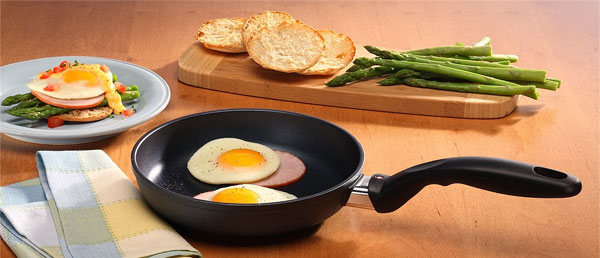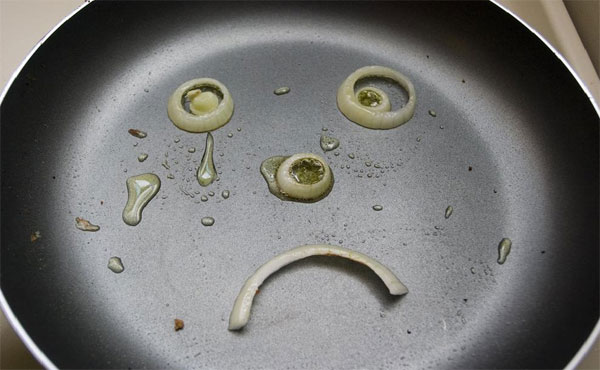Use a non-stick pan properly to protect your health
Do not rub the metal into the basin; remove oil and butter when frying; Cooking at medium temperatures . are the notes that increase the life of non-stick pans and protect health.
Non-stick pan is an essential tool in the kitchen thanks to its high heat resistance, preventing food from sticking to the pan, saving cooking oil and limiting the condition of oil-soaked food . However, not all housewives Use the pan properly.
Do not rub the metal into the basin
According to the household expert of about.com page - Ms. Mariette Mifflin, should not use abrasive materials such as knives, forks, tongs, metal spoons to reverse the food. Absolutely do not use bread, fried eggs directly in a pan. Should be cooked with wooden chopsticks, bamboo and washed with a sponge or soft towel.

The non-stick pan has many functions.
Act Au technical expert of Teflon anti-stick firm also said that metal is an enemy of non-stick layer. Even if your pan is made of pure aluminum, has a standard thickness of 2.2 - 3.2mm, coated with 2 or 3 Teflon® premium non-stick layers (Teflon® Classic, Teflon® Select or Teflon® Platinum Plus), then the needle The type can still scratch the pan surface.
Put less oil, butter when frying and frying
A small amount of frying oil and butter is needed to flavor the dish. You can even fry meat, eggs, bake bread on a non-stick pan without the need for the above, if using a pan with high stickiness.

Just put a small amount of grease into the pan.
This note also helps women limit the amount of fat intake into the body. When frying oil and butter at high temperature, it is easy to convert into harmful acids, causing cardiovascular diseases.
Cook at low or medium temperatures
There are many types of non-stick pans on the market with electrostatic paint, enamel, ceramic insulation, allumium alloys . Depending on the quality of the non-stick layer, pans can withstand different temperatures. At high temperatures, the anti-sticking agent begins to decompose and release toxic cancer-causing molecules. Therefore, you should pay attention to adjusting the temperature when using the pan, should not be used for baking, brazing or roasting meat edge. Do not put fire on the basin, absolutely do not leave the pan on a hot stove without oil, grease or food.

The non-stick Teflon coated pan can withstand temperatures up to 260 degrees Celsius, which is certified by the US Food and Drug Administration (FDA) and the US Environmental Protection Agency (EPA).
Currently, there are only a number of approved non-stick safety classes issued by reputable organizations. However, women should still cook at low or medium temperatures to ensure the longevity of the pan.
Wash with warm water
You need to keep the surface of the basin completely clean, because grease, sugar residue, salt and excess food easily reduce the ability of the pan to resist sticking. Saucepans are cleaner when cleaned with a warm water dish.
Specialist Mariette Mifflin noted, should not wash the pan when frying is finished, due to the sudden change in temperature makes the pan deformed and peeled off the non-stick layer. You should only soak or wash when the pan is nearly cooled. Soaking helps salt residues and uneaten food easier to wash.
Preserving overhead
Hanging up high prices is the best way to preserve pans. You should not put other pots and pans on the pan, avoid scratching the pan or pan deformation. The temperature and cooking oil are often uneven if the pan is distorted.

The pan should be hung on the rack and not overlapped.
You can also put a non-stick pan in the oven for baking, chicken . or store in the refrigerator if you are afraid to scoop out food. The pan is allowed into a microwave oven (large size) if the manufacturer's outer coating is not metal.
Replace the pan when the non-stick layer is damaged
The pan needs to be replaced when the pan is scratched or close to the food, usually 1-2 years of use, or 3 years if the non-stick layer is preserved.
For a durable pan, before using it for the first time, you can use the following tip: rinse the pan clean, wipe the surface of the basin with some cooking oil. This helps extend the life of the non-stick coating.
- Selfie stick was born 88 years ago?
- Using a non-stick pan may have cancer
- Gum does not stick and self-destruct
- Anti-stick substances on kitchenware increase cholesterol
- How to give emergency first aid to people suffering from acid burns
- Using the right amount of coffee can help protect the liver
- Harmful when abusing grapefruit
- Your tongue will stick to the cold metal
- Real damage nonstick agent for cooking utensils
- How to train pure eyes
- Video: Why is Teflon so good at sticking?
- Non-stick pan causes aging in women
 Soaking vegetables in salt water does not remove chemicals but you should still do it
Soaking vegetables in salt water does not remove chemicals but you should still do it You should limit bamboo shoots if you have 1 in 5 of these diseases
You should limit bamboo shoots if you have 1 in 5 of these diseases Mistakes when soaking vegetables in salt water
Mistakes when soaking vegetables in salt water Risk of death when combining shrimp with vitamin C
Risk of death when combining shrimp with vitamin C